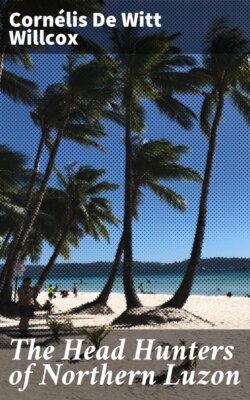Читать книгу The Head Hunters of Northern Luzon - Cornelis De Witt Willcox - Страница 13
На сайте Литреса книга снята с продажи.
Chapter IX.
ОглавлениеTable of Contents
Return to civilization.—Reception at Bambang.—Aglipayanos and Protestants.
The return to the main road from Campote was a great improvement over the advance. The sun had partly dried the trail, and his vertical rays enabled us to see about us a little, and realize what a tremendous phenomenon tropical vegetation can be. Some Philippine trees, for example, the narra, throw out buttresses. One we saw on this trail must have measured twenty feet across on the ground, from vertex to vertex of diametrically opposite buttresses, the bole itself not being over two and one-half feet in diameter, and the buttresses starting about fifteen feet above the ground. But the greatest difference to me personally was in my mount, Connor having lent me his pony, as admirable as mine of the day before had been wretched. In spite of the fact that Connor had to stay behind at Campote and could catch us up later, this attention on his part was one of the most generous things that ever happened to me, for certainly the pony he got from me was the most irritating piece of horseflesh imaginable. I am glad publicly to give him my warmest thanks again! Mr. Worcester was well mounted, too; he rode this day at two hundred and thirty-five pounds, and his kit must have weighed some thirty more, yet his little beast carried him soundly to Bambang, our destination, about seventeen miles, twelve of them at a “square, unequivocal” trot, by no means an unusual example of the strength and endurance of some of these native ponies. In what seemed a very short time (but the trail was comparatively dry) we broke out of the forest, and again had our lovely valley below and in front of us. At the top we saw some giant fly-catchers, a bird of so powerful and erratic a flight that no one has so far, according to Mr. Worcester, succeeded in killing one of them. It may be mentioned here that we saw very few birds or any other animals on our journey. Shortly after beginning the descent, some of the party, impatient of the zig-zags, decided to go straight down, the temptation being a cool green stream at the foot of the mountain; half an hour afterward, on turning a point, we could see them disporting themselves in the waters, and at that distance looking very much like Diana and her nymphs in the usual pictures.
Back in the main road, we stopped to rest at a point covered with a sensitive plant so delicate that, on stepping on it anywhere, the nervous thrill, if that is what it is, would run three or four feet or more in all directions before dying down. From this point we turned north, our way taking us through a broad open valley, past rice-fields and between clumps of flowering guava bushes. As we neared Bambang, where we were to spend the night, we were as before met by the local notabilities on horseback; and breasting a rise, we saw our road down in the plain in which this town lies, lined on both sides by all the school-children of the place, dressed in their very best clothes, some of them American fashion with shoes and stockings and looking mighty uncomfortable in consequence. Nearly everyone had a flag. Riding into the town, we found the plaza crowded with men and women, dressed mostly in white, and what with the flags, the church-bells clanging with all their might, the crowd, and the children trooping in, our cavalcade made a triumphant entrance.
We dismounted at the presidente’s, where muscatel and cocoanut milk were given us. A little muscatel goes a long way, but this is not true of the milk when one’s tongue is hanging out from riding in the sun, and there are only two or three cocoanuts. Filipinos apparently are not fond of this drink, and we nearly always had to send out and get more. No sooner were we in the house than addresses began, one of these being in Ilokano. The native language of Bambang, however, is the Isanay, spoken elsewhere only at Aritao and Dúpax, a dying tongue, doomed to early extinction.
Bambang, like nearly all the other Nueva Vizcaya towns we had seen or were to see, shows signs of decadence. It has a good church and convento, a great plaza, and is surrounded by a fertile country, but something is missing. After dinner, I went over and called on the padre, one of the Belgians, whom we had met the day before. He informed me that Bambang had many Protestants, which he explained by the sharp rivalry between the Aglipayanos, or members of the “native” church, headed by the secessionist Aglipay, and the Catholics. To avoid the issues raised by this rivalry, many natives would appear to have abandoned the errors of Rome (or of Aglipayanismo, as the case may be) for those of the Reformation.
When I got back to the presidente’s, everybody had turned in, and the house was dark. However, I found a bed not occupied by anyone else, but of my bedding there was not a sign. So I stretched out on the petate1 of my bed, only to wake up later shivering with cold, which I tried to remedy by fishing around for cover in a pile of straw mats, from which I extracted what turned out in the morning to be a jusi table-cloth, through which you could have shot straws. It is altogether a mistake to imagine that one can not be cold in the tropics.
1 The straw mat covering the “split bottom” of the native bed. There is no other mattress, and the “split bottom” constitutes the springs. Once accustomed to it, the bed is cool and comfortable.
